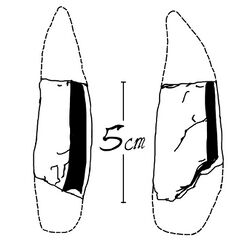Biology:Orcinus paleorca
| Orcinus paleorca | |
|---|---|

| |
| O. paleorca holotype, front view (left) and side view (right). Dotted lines indicate inferred dimensions. | |
| Scientific classification | |
| Domain: | Eukaryota |
| Kingdom: | Animalia |
| Phylum: | Chordata |
| Class: | Mammalia |
| Order: | Artiodactyla |
| Infraorder: | Cetacea |
| Family: | Delphinidae |
| Genus: | Orcinus |
| Species: | †O. paleorca
|
| Binomial name | |
| †Orcinus paleorca Matsumoto, 1937
| |
Orcinus paleorca is a fossil species of Orcinus, the genus of killer whales (orca), dated to the Middle Pleistocene.
Taxonomy
The holotype specimen, a tooth fragment, was found by G. Natsume in the Sanuki Formation in the Kazusa Province of Honshu, Japan–an area dating back to the Middle Pleistocene–and described in 1937 by Japanese paleontologist Hikoshichiro Matsumoto. Orcinus paleorca could represent the ancestor of the modern killer whale (Orcinus orca). Matsumoto noted that the teeth of O. paleorca are much larger and have more similar dimensions to the modern killer whale than those of the Pliocene O. citoniensis are.[2]
Description
The tooth is conical and belonged to the upper right or lower left jaw of an adult individual. The tooth fragment is 5 cm (2.0 in) in height–though the actual height may have been double that–2.25 cm (0.89 in) longitudinally–from the side facing the tongue to the side facing the lip–and 2.95 cm (1.16 in) transversely–from the left side of the tooth to the right.[2] In comparison, the modern killer whale has teeth around 8 cm (3.1 in) in height and 2.5 cm (0.98 in) in diameter.[3] Like the modern killer whale, the tooth lacks a coat of cementum. However, unlike the modern killer whale, O. paleorca had a circular tooth root as opposed to an oval, and the pulp extended more towards the back than the front.[2]
Paleobiology
Orcinus species, like many other predatory marine lineages, may have fished up the food chain, with the apparently more primitive O. citoniensis able to hunt large fish, and the modern killer whale's ability to hunt large whales.[4]
The Middle Pleistocene deposits indicate a warm temperate climate, and temperate forests of land. The marine mammal diversity comprises O. paleorca, an undetermined species of Orcinus, the baleen whale Mizuhoptera, an unidentified oceanic dolphin, the fossil false killer whale Pseudorca yokoyamai, the fossil walrus Odobenus mandanoensis, an undetermined species of Eumetopias sea lion, and the recently extinct Steller's sea cow (Hydrodamalis gigas).[5][6] Sharks present were the great white shark (Carcharodon carcharias) and the extinct broad-toothed mako (Cosmopolitodus hastalis).[2][7][8]
References
- ↑ Orca paleorca at fossilworks.org
- ↑ 2.0 2.1 2.2 2.3 Matsumoto, Hikoshichiro (1937). "A New Species of Orca from the Basal Calabrian at Naganuma, Minato Town, Province of Kazusa, Japan". Zoological Magazine (Japan) 49 (5): 191–193. http://dl.ndl.go.jp/view/download/digidepo_10834379_po_ART0003832313.pdf?contentNo=1&alternativeNo=.
- ↑ "Killer Whale Anatomy". Killer-Whale.org. 6 February 2014. https://www.killer-whale.org/killer-whale-anatomy/. Retrieved 14 November 2018.
- ↑ Lindberg, D. R.; Pyenson, N. D. (2006). Estes, J. A.; DeMaster, D. P.; Doak, D. F.. eds. Whales, Whaling, and Ocean Ecosystems. University of California Press. p. 77. ISBN 978-0-520-24884-7. https://books.google.com/books?id=daY_utPoJGAC&pg=PA77.
- ↑ Oishi, M.; Hasegawa, Y. (1994). "A List of Fossils Cetaceans in Japan". Island Arc 3 (4): 496. doi:10.1111/j.1440-1738.1994.tb00128.x.
- ↑ Furusawa, H.; Kohno, N. (1994). "Steller's sea-cow (Sirenia: Hydrodamalis gigas) from the Middle Pleistocene Mandano Formation of the Boso Peninsula, central Japan" (in Japanese). Japanese Paleontological Society 56. doi:10.14825/kaseki.56.0_26. https://www.jstage.jst.go.jp/article/kaseki/56/0/56_KJ00003661858/_pdf/-char/ja.
- ↑ Kawamura, Y. (1991). "Quaternary Mammalian Faunas in the Japanese Islands". Quaternary Research 30 (2): 213–220. doi:10.4116/jaqua.30.213. https://www.jstage.jst.go.jp/article/jaqua1957/30/3/30_3_213/_pdf.
- ↑ Tokunaga, S. (1933). "A List of the Fossil Mammals of Japan and Korea with Descriptions of New Eocene Forms from Korea". American Museum Novitates (627). http://digitallibrary.amnh.org/bitstream/handle/2246/2053/N0627.pdf;jsessionid=4B1D4C827AFB6D8FB8993F1E01DB87D2?sequence=1.
Wikidata ☰ Q55627821 entry
 |

